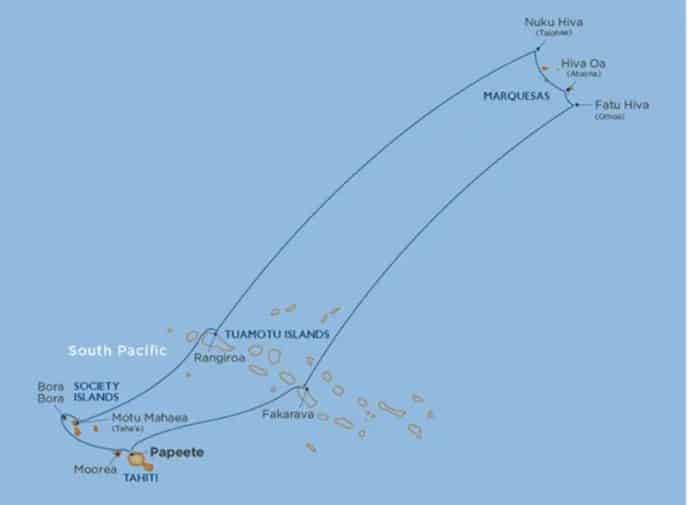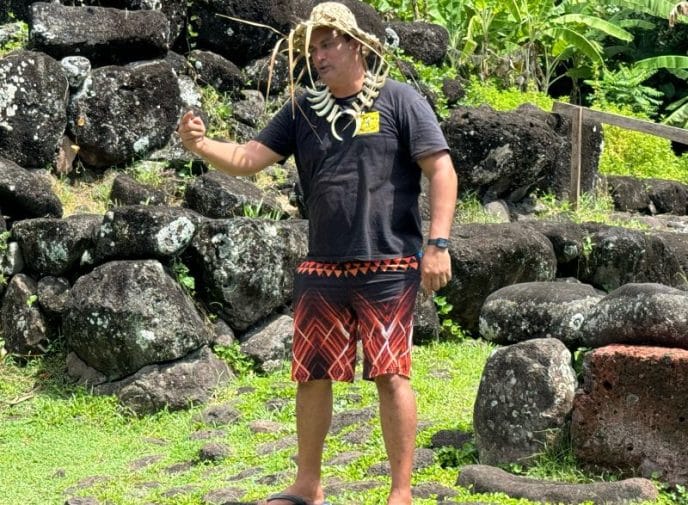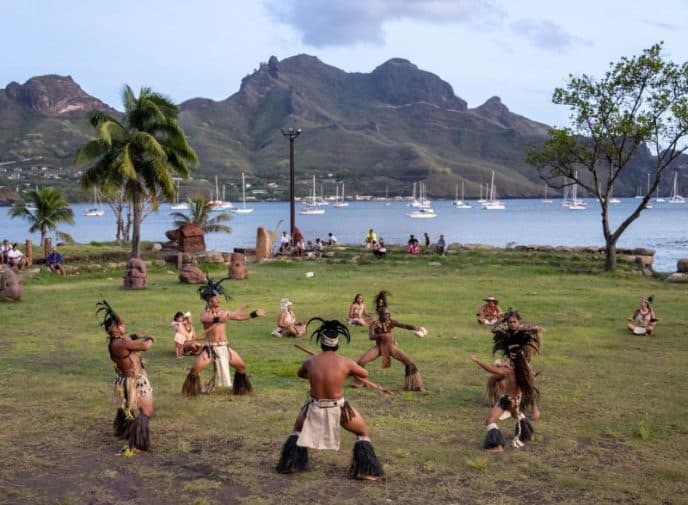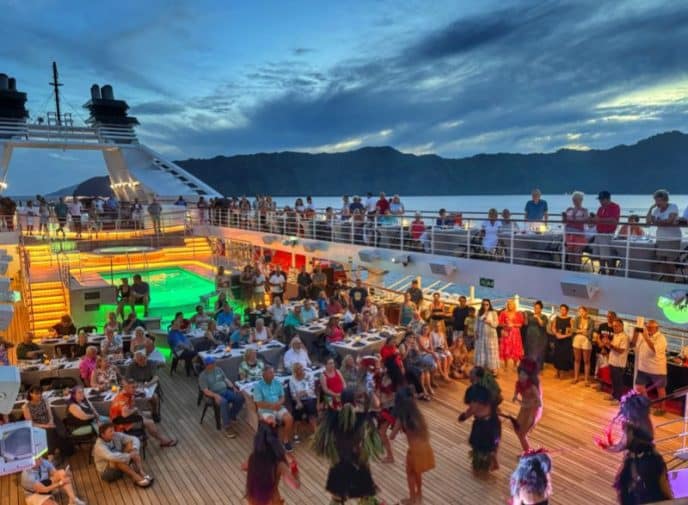We were not supposed to be headed to the Marquesas Islands. But when the captain of Star Breeze announced a dramatic change in the itinerary due to a typhoon bearing down on Tahiti, I paid close attention. “It’s going to be very windy, very wet and not very pleasant if we stay the course we planned,” Captain Simon Terry told me. “As you can appreciate, our aim is to make sure you remain comfortable and safe. So, we have taken the decision we’re going to be heading for an inaugural call in the Marquesas.”
I probably wasn’t the only one who immediately launched a Google map on their phone to figure out where we were being diverted to. But the three unexpected days we spent in the Marquesas Islands proved to be a delicious crash course in a place many of us could not have previously located on a map. Here’s what I discovered.
Lesson Learned, #1: French Polynesia really sprawls

Situated roughly halfway between South America and Australia, Tahiti is the best known and largest of this South Pacific island chain — it’s also most populated, and the starting point for most voyages. But French Polynesia is not just Tahiti, nor is it comprised of solely the Society Islands, the archipelago that stars the country’s most seductive landings, Bora Bora and Moorea. In fact, French Polynesia is made up of five distinct archipelagos, which also includes the Austral Islands, the Gambier Islands, the Tuamotu Archipelago, and the Marquesas Islands. A total of 118 islands are spread across a swath of ocean five times the size of France.
French Polynesia is already pretty remote. When we set off for the Marquesas it turned out we were headed 900 miles northeast of Tahiti. By some measures, the Marquesas are the most isolated islands in the world — farther from any continental landmass in the world (the nearest coastline is Mexico, more than 3,000 miles away). As a result, while the Marquesas have many cultural traits in common with other South Pacific islands, including Easter Island, these islands have developed an identity that is unique even within French Polynesia.
Lesson Learned, #2: The Marquesas are really distinct from other parts of French Polynesia

Most islands of French Polynesia are atolls — the remnants of ancient volcanoes that eroded over the millennia, leaving behind only an evanescent fringing coral reef, white-sand beaches, and often nothing taller than the palm trees. Younger islands, like Tahiti, have only just started — in geologic terms — the erosion process, so their topography is still mountainous. Also volcanic, the Marquesas are the youngest islands of French Polynesia and their outlines are defined by craggy peaks, some towering more than 4,000 feet on Nuku Hiva, the largest of the Marquesas. Because coral reefs are few, the beaches I saw are mostly black sand.
There is also a different climate. Though located much closer to the equator, the Marquesas are dryer than the rest of the island chain, and droughts are not uncommon. In contrast to the rest of French Polynesia, highly variable rainfall falls primarily May through July, while the northern hemisphere’s winter months are the driest period. As Star Breeze pulled into Taioha’e Bay, the main harbor on Nuku Hiva, I swooned as the clouds gradually lifted to reveal the island’s glorious, muscular outline, riven by sharp ridges and deep valleys.
Lesson learned, #3: the most surprising discoveries in the Marquesas

Because our arrival to Nuku Hiva was an unplanned inaugural call for Windstar, the Star Breeze team scrambled to put together a shore excursion that would take in the island’s major sights. There was a fleet of several dozen 4x4s to greet us, most of them driven by women, and most of whom did not speak English — the 17 words of French I recall from high school came in handy. At each stop though, an English-speaking guide named Annie provided lovely interpretation for our convoy. We started at the Notre-Dame Cathedral, built in the 1990s on a site sacred to the Marquesans who came here about 2,000 years ago. The open-air church was constructed using stones from each of the Marquesas’ inhabited islands and giant wooden sculptures depicted the stations of the cross.
Steep, green, and bathed in mist and mystery, our drive took us up and over the island to the village of Taipivai, where we followed a river lined with homes, passing a wide variety of trees, flush with breadfruit, grapefruit, mango, papaya, and banana. Pigs, horses, and countless chickens wandered unattended. If I make it back to Nuku Hiva I’ll look into hikes leading to towering waterfalls, horseback tours, hiking and diving.
The second largest of the Marquesas is Hiva Oa, and when you pull into its bay, you might notice you’re anchored at the edge of a half-submerged ancient volcanic crater, with one half of the rim rising up to a sharp fang called Mt. Feani. I skipped the tour of Hiva Oa in favor of exploring on foot — in retrospect, I missed out, as they visited a few of the island’s archeological sites, which currently sit on UNESCO’s list of prospective World Heritage sites. The island also has Polynesia’s richest collection of stone tiki scattered throughout the island. Instead, on a hot day with little breeze, I contented myself with a swim at the beach fronting the island’s main town, Atuona. Normally a bit rougher, I was told, on the day I visited it was almost lake calm. The sand here is silky black, with tiny flecks of gold that glitter in the sunlight.
One of the smallest inhabited islands in the Marquesas is Fatu Hiva, but alas, Star Breeze was not able to call here due to high seas that made a transfer to tender boats too rocky. It’s one of the most dramatic, fearsome, and alluring places I’ve almost been — 33 square miles of awesome cliffs plunging to the sea, topped by razor-thin ridges that lead to deep, narrow valleys. The volcanic isle looks uninhabitable, but about 600 people live here, we were told, and a 10-mile dirt path with hundreds of twists and turns snakes from the port of Omoa on the south end to Hanavave in the north.
Lesson learned, #4: the Marquesas attract an unusual type of celebrity

Okay, the Marquesas are not the place to visit in search of celebrities, but several notables have made their way to these far-flung islands. Norwegian ethnographer Thor Heyerdahl, who led the Kon Tiki expedition in 1947, lived with his first wife on Fatu Hiva, of all places, immediately after they married. Living off the land in largely primitive circumstances for 15 months, it was here that Heyerdahl first developed his theories about trans-Oceanic contact between people of Polynesia and South American cultures.
On Nuku Hiva, Annie explained how the village of Taipivai is where author Herman Melville jumped ship in 1842 and hid among cannibal tribes, where he was accepted into the community. This experience was the foundation for his book, “Typee,” before he went on to write “Moby Dick.” I knew the one about the white whale, but that earlier book might offer an interesting glimpse into Marquesan culture and identity.
Hiva Oa is no slouch in the name-dropping department. Impressionist painter Paul Gauguin spent the last 8 years of his life here, first on Tahiti and eventually Hiva Oa, where he painted and sculpted with wood until his death in 1903. The island’s other brush with fame was when Belgian singer-songwriter-actor Jacques Brel, who sold more than 25 million records, spent most of the last 3 years of his life on Hiva Oa — he passed away in 1978. In the village there are small museums devoted to each, and include a replica of Gauguin’s house and the actual plane Brel flew in. I walked up the hill to the small Calvaire Cemetery where the artists are buried amid frangipani trees. Both are said to have settled in the Marquesas specifically for their isolation, and their graves are simple and special.
Lesson learned, #5: instead of touristy shopping sites, you’ll discover wonderful, locally-made souvenirs

Let no one tell you the Marquesas are a place to go shopping for souvenirs. But maybe Gauguin and Brel were attracted to more than the isolation — it may also have been the Marquesas’ artistic legacy: Some of Polynesia’s most respected tattoo artists are said to be from here, and carving on wood, bone and stone is renowned, crafts that spread to Hawaii, Easter Island and New Zealand. In retrospect, I wish I’d spent more time examining the wares available in the small galleries on Nuku Hiva and Hiva Oa. A few days later, in Bora Bora and Tahiti I found galleries selling the exquisite carvings of the Marquesas, at lofty prices. (There is also a small selection offered in the boutique aboard Star Breeze, at what seemed like fair prices relative to shops on the islands.)
I like strolling through the grocery stores of remote places — what are the things they can’t grow or catch easily in the Marquesas? Fortunately, what I did find at the main grocer in Hiva Oa was definitely worth bringing home: miel des Marquesas, honey of the islands. I grabbed a couple jars off the shelf, and when gifting one to a friend at home I said, this might be the purest, most untainted honey you will ever taste.
Windstar’s Star Breeze offers special voyages to the Marquesas Islands via its Star Collector: Comprehensive Tahiti and Marquesas Adventure and Tahitian Treasures and Magnificent Marquesas.






So enjoyed reading about the Marquesas islands and so many of your publications, including Greek Foods!
Love Windstar!
Thank you for the nice words! –Carolyn